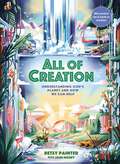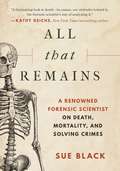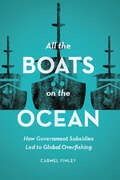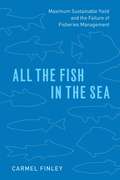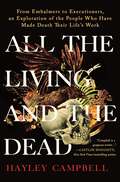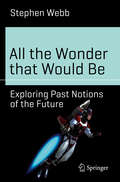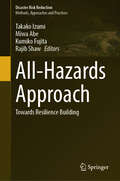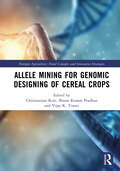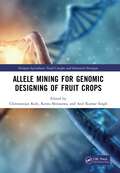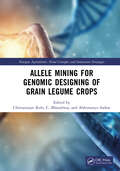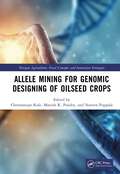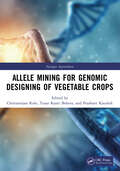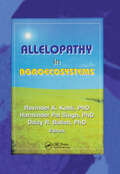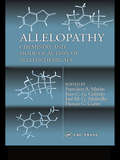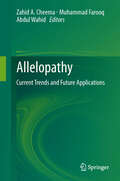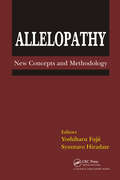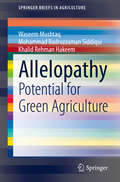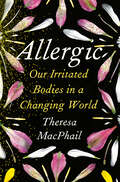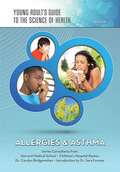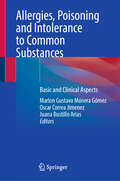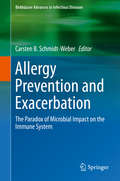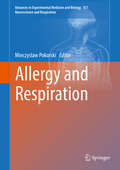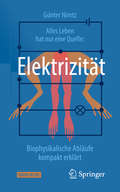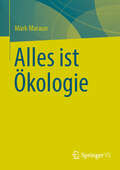- Table View
- List View
All of Creation: Understanding God’s Planet and How We Can Help
by Betsy PainterFrom conservation to protecting endangered species to sustainable living, All of Creation offers young readers accessible and fascinating information on the challenges our planet faces and practical ways we can care for the magnificent world around us.Drawing on science and Scripture, this hope-filled and kid-friendly guide to planet Earth addresses our most pressing questions about caring for and respecting God's world, such as:What are the biggest challenges our planet faces, and what impact do they have on our lives?What guidance does the Bible offer to help us navigate environmental issues such as pollution, food shortages, and deforestation?What simple choices can we make to help restore and protect God's creation? Gorgeously detailed illustrations throughout highlight the beauty of the natural world, while practical tips and activities at the end of each chapter show how we can become better stewards of the Earth and support efforts that make a positive difference in the world.All of Creation is ideal for:Readers ages 8-12 who are interested in conservation and the environmentYoung people who want to get involved but don&’t know where to startGift-giving occasions such as birthdays, Christmas, Easter, and other holidays
All that Remains: A Renowned Forensic Scientist on Death, Mortality, and Solving Crimes
by Sue BlackBook of the Year, 2018 Saltire Literary Awards For fans of Caitlin Doughty, Mary Roach, and CSI shows, a renowned forensic scientist on death and mortality. Dame Sue Black is an internationally renowned forensic anthropologist and human anatomist. She has lived her life eye to eye with the Grim Reaper, and she writes vividly about it in this book, which is part primer on the basics of identifying human remains, part frank memoir of a woman whose first paying job as a schoolgirl was to apprentice in a butcher shop, and part no-nonsense but deeply humane introduction to the reality of death in our lives. It is a treat for CSI junkies, murder mystery and thriller readers, and anyone seeking a clear-eyed guide to a subject that touches us all. Cutting through hype, romanticism, and cliché, she recounts her first dissection; her own first acquaintance with a loved one’s death; the mortal remains in her lab and at burial sites as well as scenes of violence, murder, and criminal dismemberment; and about investigating mass fatalities due to war, accident, or natural disaster, such as the 2004 Indian Ocean tsunami. She uses key cases to reveal how forensic science has developed and what her work has taught her about human nature. Acclaimed by bestselling crime writers and fellow scientists alike, All That Remains is neither sad nor macabre. While Professor Black tells of tragedy, she also infuses her stories with a wicked sense of humor and much common sense.
All the Boats on the Ocean: How Government Subsidies Led to Global Overfishing
by Carmel FinleyMost current fishing practices are neither economically nor biologically sustainable. Every year, the world spends $80 billion buying fish that cost $105 billion to catch, even as heavy fishing places growing pressure on stocks that are already struggling with warmer, more acidic oceans. How have we developed an industry that is so wasteful, and why has it been so difficult to alter the trajectory toward species extinction? In this transnational, interdisciplinary history, Carmel Finley answers these questions and more as she explores how government subsidies propelled the expansion of fishing from a coastal, in-shore activity into a global industry. While nation states struggling for ocean supremacy have long used fishing as an imperial strategy, the Cold War brought a new emphasis: fishing became a means for nations to make distinct territorial claims. A network of trade policies and tariffs allowed cod from Iceland and tuna canned in Japan into the American market, destabilizing fisheries in New England and Southern California. With the subsequent establishment of tuna canneries in American Samoa and Puerto Rico, Japanese and American tuna boats moved from the Pacific into the Atlantic and Indian Oceans after bluefin. At the same time, government subsidies in nations such as Spain and the Soviet Union fueled fishery expansion on an industrial scale, with the Soviet fleet utterly depleting the stock of rosefish (or Pacific ocean perch) and other groundfish from British Columbia to California. This massive global explosion in fishing power led nations to expand their territorial limits in the 1970s, forever changing the seas. Looking across politics, economics, and biology, All the Boats on the Ocean casts a wide net to reveal how the subsidy-driven expansion of fisheries in the Pacific during the Cold War led to the growth of fisheries science and the creation of international fisheries management. Nevertheless, the seas are far from calm: in a world where this technologically advanced industry has enabled nations to colonize the oceans, fish literally have no place left to hide, and the future of the seas and their fish stocks is uncertain.
All the Fish in the Sea: Maximum Sustainable Yield and the Failure of Fisheries Management
by Carmel FinleyBetween 1949 and 1955, the State Department pushed for an international fisheries policy grounded in maximum sustainable yield (MSY). The concept is based on a confidence that scientists can predict, theoretically, the largest catch that can be taken from a species’ stock over an indefinite period. And while it was modified in 1996 with passage of the Sustained Fisheries Act, MSY is still at the heart of modern American fisheries management. As fish populations continue to crash, however, it is clear that MSY is itself not sustainable. Indeed, the concept has been widely criticized by scientists for ignoring several key factors in fisheries management and has led to the devastating collapse of many fisheries. Carmel Finley reveals that the fallibility of MSY lies at its very inception—as a tool of government rather than science. The foundational doctrine of MSY emerged at a time when the US government was using science to promote and transfer Western knowledge and technology, and to ensure that American ships and planes would have free passage through the world’s seas and skies. Finley charts the history of US fisheries science using MSY as her focus, and in particular its application to halibut, tuna, and salmon fisheries. Fish populations the world over are threatened, and All the Fish in the Sea helps to sound warnings of the effect of any management policies divested from science itself.
All the Living and the Dead: From Embalmers to Executioners, an Exploration of the People Who Have Made Death Their Life's Work
by Hayley CampbellA deeply compelling exploration of the death industry and the people—morticians, detectives, crime scene cleaners, embalmers, executioners—who work in it and what led them there.We are surrounded by death. It is in our news, our nursery rhymes, our true-crime podcasts. Yet from a young age, we are told that death is something to be feared. How are we supposed to know what we’re so afraid of, when we are never given the chance to look?Fueled by a childhood fascination with death, journalist Hayley Campbell searches for answers in the people who make a living by working with the dead. Along the way, she encounters mass fatality investigators, embalmers, and a former executioner who is responsible for ending sixty-two lives. She meets gravediggers who have already dug their own graves, visits a cryonics facility in Michigan, goes for late-night Chinese with a homicide detective, and questions a man whose job it is to make crime scenes disappear.Through Campbell’s incisive and candid interviews with these people who see death every day, she asks: Why would someone choose this kind of life? Does it change you as a person? And are we missing something vital by letting death remain hidden? A dazzling work of cultural criticism, All the Living and the Dead weaves together reportage with memoir, history, and philosophy, to offer readers a fascinating look into the psychology of Western death.
All the Wonder that Would Be: Exploring Past Notions of the Future (Science and Fiction)
by Stephen WebbIt has been argued that science fiction (SF) gives a kind of weather forecast - not the telling of a fortune but rather the rough feeling of what the future might be like. The intention in this book is to consider some of these bygone forecasts made by SF and to use this as a prism through which to view current developments in science and technology. In each of the ten main chapters - dealing in turn with antigravity, space travel, aliens, time travel, the nature of reality, invisibility, robots, means of transportation, augmentation of the human body, and, last but not least, mad scientists - common assumptions once made by the SF community about how the future would turn out are compared with our modern understanding of various scientific phenomena and, in some cases, with the industrial scaling of computational and technological breakthroughs. A further intention is to explain how the predictions and expectations of SF were rooted in the scientific orthodoxy of their day, and use this to explore how our scientific understanding of various topics has developed over time, as well as to demonstrate how the ideas popularized in SF subsequently influenced working scientists. Since gaining a BSc in physics from the University of Bristol and a PhD in theoretical physics from the University of Manchester, Stephen Webb has worked in a variety of universities in the UK. He is a regular contributor to the Yearbook of Astronomy series and has published an undergraduate textbook on distance determination in astronomy and cosmology as well as several popular science books.
All-Hazards Approach: Towards Resilience Building (Disaster Risk Reduction)
by Rajib Shaw Takako Izumi Miwa Abe Kumiko FujitaThis book presents case studies of risk management of various hazards and risk management systems at regional, national, and local levels. It also proposes a comprehensive approach to reduce future risks by collaborating with various stakeholders and preparing for the most effective responses toward complicated hazards, minimizing social damage.The COVID-19 pandemic has increased the concern as well as interest in the diversification of future risks and the complexity of the damage and impact that multiple risks may cause. These hazard risks include not only natural hazards, but also biological, industrial, and nuclear hazards along with other risks such as cyber-attacks, climate change, food security, conflict, and multiple hazards occurring simultaneously.The Sendai Framework for Disaster Risk Reduction, adopted in 2015 at the United Nations World Conference on Disaster Risk Reduction, accounts for the risks caused by natural or manmade hazards as well as related environmental, technological, and biological hazards and risks. The framework guides the multi-hazard management of disaster risk in development at all levels and sectors. However, in the current disaster management system in most countries, different offices are responsible for each different hazard, making it extremely difficult to manage those hazard risks comprehensively.Having experienced the COVID-19 pandemic, it is now time to review the current risk management strategy and system, and thereafter discuss how to strengthen and transform our risk perception and manner of risk assessment and identification to tackle future multiple hazards. Simultaneously, further collaboration among experts from different backgrounds and fields will become indispensable. While the discussion of the need for an “all-hazards approach” has taken place for many years, there now needs to be discussion of a risk-focused framework.
Allele Mining for Genomic Designing of Cereal Crops (Nextgen Agriculture)
by Chittaranjan Kole Sharat Kumar Pradhan Vijay K TiwariThis book deliberates on the concept, strategies, tools, and techniques of allele mining in cereal crops and its application potential in genome elucidation and improvement, including studying allele evolution, discovery of superior alleles, discerning new haplotypes, assessment of intra- and interspecific similarity, and studies of gene expression and gene prediction. Available gene pools in global germplasm collections specifically consisting of wild allied species and local landraces for almost all major crops have facilitated allele mining. Development of advanced genomic techniques including PCR-based allele priming and Eco-TILLING-based allele mining are being widely used now for mining superior alleles. Allele's discovery has become more relevant now for employing molecular breeding to develop designed crop varieties matching consumer needs and with genome plasticity to adapt the climate change scenarios. All these concepts and strategies along with precise success stories are presented in the chapters dedicated to the major cereal crops. The first book on the novel strategy of allele mining in cereal crops for precise breeding Presents genomic strategies for mining superior alleles underlying agronomic traits from genomic resources Depicts case studies of PCR-based allele priming and Eco-Tilling-based allele mining Elaborates on gene discovery and gene prediction in major cereal crops This book will be useful to the students and faculties in various plant science disciplines including genetics, genomics, molecular breeding, agronomy, and bioinformatics; the scientists in seed industries; and the policymakers and funding agencies interested in crop improvement.
Allele Mining for Genomic Designing of Fruit Crops (Nextgen Agriculture)
by Chittaranjan Kole Anil Kumar Singh Kenta ShirasawaThis book deliberates on the concept, strategies, tools, and techniques of allele mining in fruit crops and its application potential in genome elucidation and improvement including studying allele evolution, discovery of superior alleles, discerning new haplotypes, assessment of intra- and interspecific similarity, and also studies of gene expression and gene prediction. Available gene pools in global germplasm collections specifically consisting of wild allied species and local landraces for almost all major crops have facilitated allele mining. Advanced genomic techniques have been developed including PCR-based allele priming and Eco-TILLING-based allele mining that are being widely used now for mining superior alleles. Allele discovery has become more relevant now for employing molecular breeding to develop designed crop varieties matching with consumer needs and also with genome plasticity to adapt the climate change scenarios. All these concepts and strategies along with precise success stories are presented over the chapters dedicated to the major fruit crops.The features of this book are as follows: The first book on the novel strategy of allele mining in fruit crops for precise breeding Presents genomic strategies of mining superior alleles underlying agronomic traits from genomic resources Depicts case studies of PCR-based allele priming and Eco-TILLING-based allele mining Elaborates on gene discovery and gene prediction in major fruit crops This book will be useful to students and faculties in various plant science disciplines including genetics, genomics, molecular breeding, agronomy, and bioinformatics; scientists in seed industries; and also policy makers and funding agencies interested in crop improvement.
Allele Mining for Genomic Designing of Grain Legume Crops (Nextgen Agriculture)
by Chittaranjan Kole C. Bharadwaj Abhimanyu SarkarThis book deliberates on the concept, strategies, tools, and techniques of allele mining in grain legume crops and its application potential in genome elucidation and improvement, including studying allele evolution, discovery of superior alleles, discerning new haplotypes, assessment of intra- and interspecific similarity, and also studies of gene expression and gene prediction. Available gene pools in global germplasm collections specifically consisting of wild allied species and local landraces for almost all major crops have facilitated allele mining. Development of advanced genomic techniques, including PCR-based allele priming and EcoTILLING-based allele mining, is being widely used now for mining superior alleles. Allele's discovery has become more relevant now for employing molecular breeding to develop designed crop varieties matching consumer needs, and also with genome plasticity to adapt to climate change scenarios. All these concepts and strategies, along with precise success stories, are presented in the chapters dedicated to the major grain legume crops.1. The first book on the novel strategy of allele mining in grain legume crops for precise breeding.2. Presents genomic strategies for mining superior alleles underlying agronomic traits from genomic resources.3. Depicts case studies of PCR-based allele priming and EcoTILLING-based allele mining.4. Elaborates on gene discovery and gene prediction in major grain legume crops.This book will be useful to students and faculties in various plant science disciplines, including genetics, genomics, molecular breeding, agronomy, and bioinformatics; to scientists in seed industries; and also to policymakers and funding agencies interested in crop improvement.
Allele Mining for Genomic Designing of Oilseed Crops (Nextgen Agriculture)
by Chittaranjan Kole Manish K. Pandey Naveen PuppalaThis book deliberates on the concept, strategies, tools, and techniques of allele mining in oilseed crops and its application potential in genome elucidation and improvement, including studying allele evolution, discovery of superior alleles, discerning new haplotypes, assessment of intra- and interspecific similarity, and studies of gene expression and gene prediction. Available gene pools in global germplasm collections, specifically consisting of wild allied species and local landraces for almost all major crops, have facilitated allele mining. The development of advanced genomic techniques, including PCR-based allele priming and Eco-TILLING-based allele mining, is now widely used for mining superior alleles. Allele's discovery has become more relevant now for employing molecular breeding to develop designed crop varieties matching consumer needs and with genome plasticity to adapt to climate change scenarios. All these concepts and strategies, along with precise success stories, are presented in the chapters dedicated to the major oilseed crops.1. This is the first book on the novel strategy of allele mining in oilseed crops for precise breeding.2. This book presents genomic strategies for mining superior alleles underlying agronomic traits from genomic resources.3. This book depicts case studies of PCR-based allele priming and Eco-TILLING based allele mining.4. This book elaborates on gene discovery and gene prediction in major oilseed crops.This book will be useful to students and faculties in various plant science disciplines, including genetics, genomics, molecular breeding, agronomy, and bioinformatics; scientists in seed industries; and policymakers and funding agencies interested in crop improvement.
Allele Mining for Genomic Designing of Vegetable Crops (Nextgen Agriculture)
by Chittaranjan Kole Tusar Kanti Behera Prashant KaushikThis book deliberates on the concept, strategies, tools, and techniques of allele mining in vegetable crops and its application potential in genome elucidation and improvement including studying allele evolution, discovery of superior alleles, discerning new haplotypes, assessment of intra- and interspecific similarity, and studies of gene expression and gene prediction. Available gene pools in global germplasm collections specifically consisting of wild allied species and local landraces for almost all major crops have facilitated allele mining. Development of advanced genomic techniques including PCR-based allele priming and Eco-TILLING based allele mining are being widely used now for mining superior alleles. Allele's discovery has become more relevant now for employing molecular breeding to develop designed crop varieties matching consumer needs and with genome plasticity to adapt the climate change scenarios. All these concepts and strategies along with precise success stories are presented in the chapters dedicated to the major vegetable crops. The first book on the novel strategy of allele mining in vegetable crops for precise breeding Presents genomic strategies for mining superior alleles underlying agronomic traits from genomic resources Depicts case studies of PCR-based allele priming and Eco-TILLING based allele mining Elaborates on gene discovery and gene prediction in major vegetable crops This book will be useful to the students and faculties in various plant science disciplines including genetics, genomics, molecular breeding, agronomy, and bioinformatics; the scientists in seed industries; and, the policymakers and funding agencies interested in crop improvement.
Allelopathy in Agroecosystems
by Ravinder Kumar Kohli Harminder Pal Singh Daizy Rani BatishDiscover environmentally safe ways to control weeds and pests!Until now farmers have had to choose between using expensive herbicides and fertilizers, which pollute the water table, or watching crop yields drop. All too often, crop yields dropped anyway, despite intensive farming. Allelopathy in Agroecosystems offers fresh hope. It provides an in-depth understanding of allelopathy-the mysterious, complex biochemical interactions among plants and microbes. This little-understood phenomenon plays a large role in agriculture, for good or ill. It can lead to changes in nutrient dynamics, vegetation structure, and species diversity.This comprehensive treatise is the first compendium devoted to explaining and exploring these chemical interactions in agricultural crop systems. Allelopathy in Agroecosystems explains how these interactions can make soil “sick,” especially in intensively cropped areas. This leads to less growth and lower yield. On the other hand, it has great potential as an environmentally safe method of weed and pest management. The fascinating original research presented here will help you understand the complexities of this invisible yet potent force in agriculture.Allelopathy in Agroecosystems examines this interaction as it affects the most important concerns of farmers and agronomists, including: beneficial interactions between crops weed control using crop residues crop rotation natural herbicides genetic engineering soil rhizosphere bacteria improving pastures forest/crop interactions sustainable management of agroecosystems new directions for research International in scope, Allelopathy in Agroecosystems offers an abundance of scientific data on this revolutionary new concept. It offers incalculable potential for rescuing farmed-out land, increasing crop yields, and cutting back on expensive soil additives. Every agronomist, environmental scientist, policymaker, agricultural librarian, and advocate of sustainable farming needs this book.
Allelopathy: Chemistry and Mode of Action of Allelochemicals
by Francisco A. Macías Juan C. G. Galindo José M. G. Molinillo Horace G. CutlerMost, if not all, books on allelopathy cover the ecological, agronomic, and descriptive physiological aspects. And although the amount of papers published on the chemical aspects and mode of action of these compounds continues to rise, there has been, until now, no book available that reflects the latest literature. Written by experts, Allelopathy:
Allelopathy: Current Trends and Future Applications
by Muhammad Farooq Abdul Wahid Zahid A. CheemaAllelopathy is an ecological phenomenon by which plants release organic chemicals (allelochemicals) into the environment influencing the growth and survival of other organisms. In this book, leading scientists in the field synthesize latest developments in allelopathy research with a special emphasis on its application in sustainable agriculture. The following topics are highlighted: Ecological implications, such as the role of allelopathy during the invasion of alien plant species; regional experiences with the application of allelopathy in agricultural systems and pest management; the use of microscopy for modeling allelopathy; allelopathy and abiotic stress tolerance; host allelopathy and arbuscular mycorrhizal fungi; allelopathic interaction with plant nutrition; and the molecular mechanisms of allelopathy. This book is an invaluable source of information for scientists, teachers and advanced students in the fields of plant physiology, agriculture, ecology, environmental sciences, and molecular biology.
Allelopathy: New Concepts & Methodology
by Yoshiharu Fujii Syuntaro HiradateThe principal goal of allelopathy is to foster sustainable agriculture, forestry, and environment. The objective is to minimize the industrial chemicals and to maximize the use of natural resources locally available while improving crop productivity, forestry and the environment. The technological advances made in allelopathy research in recent years have been created, analyzed, and developed by scientific establishments throughout the world. They present exciting and intellectually challenging problems which are solvable using modern techniques. These modern and advanced techniques as described in the chapters presented in this volume are representative of the exciting research and development approaches today.
Allelopathy: Potential for Green Agriculture (SpringerBriefs in Agriculture)
by Khalid Rehman Hakeem Waseem Mushtaq Mohammad Badruzzaman SiddiquiAllelopathic studies may be defined in various aspects; weed against weed/crop and vice versa. This book focuses on the ways to utilize the allelopathic potential of weeds or crops for controlling weeds in the agroecosystems. Vigorous use of herbicides is poisoning our environment at an alarming rate; allelopathy can be employed as a useful alternative to control weeds naturally under field conditions. The book contains chapters on the history of allelopathy; allelopathic potential of several important crops (rice, wheat, sorghum, maize, mustard, sunflower) and weeds (members of Solanaceae, Convolvulaceae, Asteraceae, Verbenaceae). Moreover, it highlights how the allelopathic potential of these weeds and crops can be employed effectively to suppress weeds under field conditions. The book also discusses topics on the role of allelochemicals in agroecosystems; impact on local flora; biotic stress induced by allelochemicals; mechanism of action of allelochemicals and future prospective of allelopathy. Prepared with basic concepts and importance of allelopathy, this book is intended for the agricultural community, botanists, students and researchers.
Allergenic Pollen: A Review of the Production, Release, Distribution and Health Impacts
by Mikhail Sofiev Karl-Christian BergmannThis is the first book to summarize all aspects of allergenic pollen: production, atmospheric distribution, and health impacts, as well as the means of monitoring and forecasting these phenomena. Based on a four-year effort by a large group of leading European scientists, this book highlights the new developments in research on allergenic pollen, including the modelling prospects and effects of climate change. The multidisciplinary team of authors offers insights into the latest technology of detection of pollen and its allergenic properties, forecasting methods, and the influence of allergenic pollen on the population. The comprehensive coverage in this book makes it an indispensible volume for anyone dealing with allergenic pollen worldwide. Readers involved in environmental health, aerobiology, medicine, and plant science will find this book of interest.
Allergic: Our Irritated Bodies in a Changing World
by Theresa MacPhailAn &“important and deeply researched&” (The Wall Street Journal) exploration of allergies, from their first medical description in 1819 to the cutting-edge science that is illuminating the changes in our environment and lifestyles that are making so many of us sickHay fever. Peanut allergies. Eczema. Either you have an allergy or you know someone who does. Billions of people worldwide—an estimated 30 to 40 percent of the global population—have some form of allergy. Even more concerning, over the last decade the number of people diagnosed with an allergy has been steadily increasing, placing an ever-growing medical burden on individuals, families, communities, and healthcare systems.Medical anthropologist Theresa MacPhail, herself an allergy sufferer whose father died of a beesting, set out to understand why. In pursuit of answers, MacPhail studied the dangerous experiments of early immunologists as well as the mind-bending recent development of biologics and immunotherapies that are giving the most severely impacted patients hope. She scaled a roof with an air-quality controller who diligently counts pollen by hand for hours every day; met a mother who struggled to use WIC benefits for her daughter with severe food allergies; spoke with doctors at some of the finest allergy clinics in the world; and discussed the intersecting problems of climate change, pollution, and pollen with biologists who study seasonal respiratory allergies.This is the story of allergies: what they are, why we have them, and what that might mean about the fate of humanity in a rapidly changing world.
Allergies & Asthma: A Teen's Guide To Contraception And Pregnancy (Young Adult's Guide to the Science of He #15)
by Jean FordWhat do cats, dogs, peanuts, latex, mold, bee venom, pollen, and shellfish all have in common? They're all common allergens; they cause allergic reactions in many people. With so many potential triggers, it's no wonder allergies are a major cause of illness in North America. In fact, allergies affect about 20 percent of the entire population. That means for every five people you know, one probably itches or sneezes from something sometimes. That might include you. Asthma is one of the many illnesses allergies can cause. Since asthma and allergies are chronic conditions--in other words, they don't go away--they require constant management. The better informed you are, the better you will be able to live with allergies or asthma. This book will show you how to take control of allergies and asthma. The first step is to form a partnership with your doctor or other medical practitioner. Don't let allergies or asthma control your life. Get informed...take action...and breathe easy.
Allergies, Poisoning and Intolerance to Common Substances: Basic and Clinical Aspects
by Marlon Gustavo Múnera Gómez Oscar Correa Jimenez Juana Bustillo AriasThe purpose of this book is to provide guidance on issues that can be confused in clinical practice such as allergies, intolerance, and poisoning to common substances like alcohol, certain foods (meats, shellfish, and vegetables), medications, metals, and vitamins, among others. Our experience in the study of allergic diseases and toxicology at the clinical and basic level has shown that there is some confusion and difficulty to understand the underlying mechanisms in the development of allergic responses and intolerance, for example, to shellfish. This often delays or may mislead the diagnosis and management of both clinical entities. For this reason, this book offers a structure that allows, first, to understand the bases of the allergic response to different substances of consumption or frequent exposure. Second, to compare the mechanisms explaining the intolerance towards these substances. For example, in the chapter discussing allergy and intolerance to dairy products, we present an immune mechanism mediated by IgE in the case of allergy, while intolerance indicates a metabolic mechanism of enzyme deficiency. However, in both cases there are usually errors or misinterpretation in their knowledge. Lastly, regarding toxicology, the bases of poisoning by these substances will be described when applicable. This is the case of alcohol, for example. The work will be a useful tool for the training of medical personnel in these areas and for students and researchers interested in the investigation of these phenomena.
Allergy Prevention and Exacerbation: The Paradox of Microbial Impact on the Immune System (Birkhäuser Advances in Infectious Diseases)
by Carsten B. Schmidt-WeberAllergy is developing into one of the most prevalent diseases affecting individuals in the very early days of life. While the cause of this epidemic is still unclear, it appears that the westernized life style is playing an important role, which includes nutrition, possibly air pollution as well as hygienic conditions. While epidemiologic studies were able to narrow down these factors, basic research discovered novel mechanisms that control the organism#65533;s tolerance against allergens. Particularly interesting is the role of microorganisms that colonize or infect a host and thereby cause damage and immunological activation followed by sensitization or exacerbation of already existing sensitizations. However at the same time microbial activation of the immune system can help to generate a protective immunity that prevents allergen sensitization. The current book is collecting these evidences and connects epidemiologic and clinical mechanistic knowledge. Only the synthesis of this knowledge will help to find solutions to the ongoing allergy epidemic in terms of public health activities, prevention and therapy.
Allergy and Respiration (Advances in Experimental Medicine and Biology #921)
by Mieczyslaw PokorskiAllergy is an increasing health issue. It often targets the respiratory tract and entwines with respiratory ailments, which makes it difficult to discern the cause-effect linkage. Nonetheless, measures to counter the allergic background are a linchpin in preserving respiratory health. This book is an update on current advances in clinical and basic science on allergy and related topics. The diagnostics of allergy requires a multidisciplinary approach, including molecular examinations aimed at unraveling the intracellular control cascades. Chapters give insight into the innovations concerning modern pulmonary function tests, discuss pharmacological paradigms, and tackle the overlapping infectious aspects and clinical symptoms and markers. Environmental and genetic factors elicit a spectrum of inflammatory phenotypes linked to differential body responses to allergic perturbations. The book is intended for healthcare professionals, notably pulmonologists, primary care physicians, and medical researchers.
Alles Leben hat nur eine Quelle: Biophysikalische Abläufe kompakt erklärt
by Günter NimtzWelche Bedeutung hat die Elektrizität für das Leben, insbesondere für das menschliche? Welche Rolle spielt sie für die Zellen, den Körper und seine Funktionen, für das Denken und Handeln der Menschen? Der Physiker Günter Nimtz erläutert in seinem Buch kompakt und leicht verständlich, welche Bedeutung die Elektrizität für biologische Prozesse und damit für das Leben hat.Zusammenhänge zwischen elektrischen Strömen und Lebensfunktionen wurden schon früh entdeckt. So erkannte der italienische Anatomieprofessor Luigi Galvani um das Jahr 1780 durch seine sensationellen Untersuchungen, dass elektrischer Strom Froschschenkel bewegt. Heute ist bekannt, dass die elektromagnetische Kraft und seine Wechselwirkung Ionen, Atome, Moleküle und chemische Reaktionen beherrschen. Alle lebenswichtigen Prozesse fußen auf elektrischen Signalen und deren Übertragung. Verhaltensweisen von primitivem Leben bis zu dem der Menschen erfolgen durch elektrische Impulse. Gedankenabläufe sind als elektrische Vorgänge nachweisbar.Der Autor führt kurzweilig in die physikalischen Konzepte ein und veranschaulicht an vielen Beispielen, wie Elektrizität Leben ermöglicht – von der einzelnen Körperzelle bis hin zu Funktionen des Gehirns. Damit richtet sich das Buch an alle, die sich für naturwissenschaftliche, biologische und physikalische Hintergründe des Lebens interessieren.
Alles ist Ökologie
by Mark MaraunDie Idee des Buches ist es zu zeigen, dass Ökologie keine Teildisziplin innerhalb der Naturwissenschaften ist, sondern große Bedeutung für alle Bereiche unseres Lebens hat. Überall wo Organismen interagieren (und das ist ja quasi überall der Fall) gelten die Prinzipien der Ökologie - nur welche sind das überhaupt?
